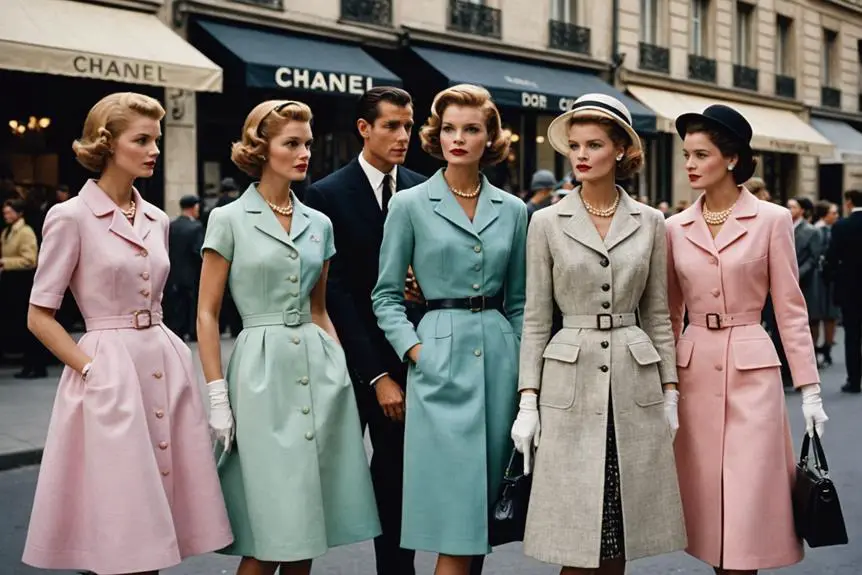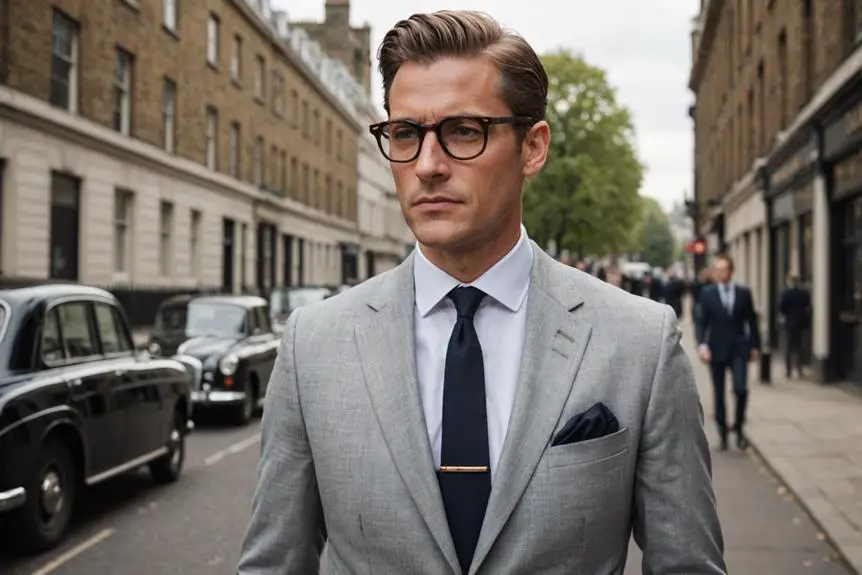In the early 1950s, fashion brands like Christian Dior and Coco Chanel led the way, creating iconic styles that defined the decade. Dior's "New Look" celebrated femininity with nipped-in waists and full skirts, while Chanel's tailored suits combined elegance with comfort. Cristóbal Balenciaga introduced innovative silhouettes, like the sack dress, challenging traditional notions of femininity. Hubert de Givenchy dressed stars like Audrey Hepburn, making the little black dress a timeless classic. These brands not only shaped fashion but also mirrored the cultural shifts of the time, particularly influenced by Hollywood glam and emerging subcultures. There's plenty more to discover about this vibrant era!
Overview of 1950s Fashion Brands
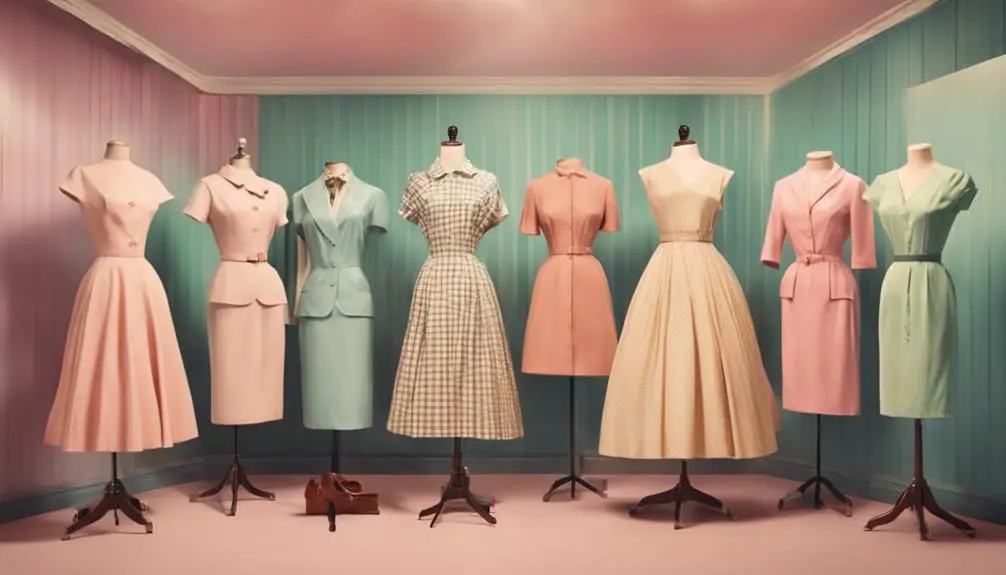
When you think of 1950s fashion, several iconic brands immediately come to mind that shaped the era's style. One of the most influential was Christian Dior, who revolutionized women's fashion with his "New Look." This stunning style featured nipped-in waists and voluminous skirts, creating an hourglass silhouette that celebrated femininity and luxury. Dior's designs made women feel elegant and sophisticated.
Coco Chanel made an impressive comeback during this time, reintroducing the iconic Chanel suit. This blend of practicality and elegance quickly became a staple in women's wardrobes, showcasing a more modern and confident woman.
Meanwhile, Cristóbal Balenciaga gained recognition for his innovative, sculptural designs, including the sack dress, which offered a looser fit while maintaining style and grace.
Hubert de Givenchy also made waves in the fashion industry with his sophisticated and elegant designs. He famously dressed stars like Audrey Hepburn, creating timeless pieces that defined chic style. His work emphasized the importance of elegance in everyday fashion.
Pierre Balmain contributed to this era as well, celebrated for luxurious creations characterized by intricate embroidery and rich fabrics. His designs attracted Hollywood stars and the elite, cementing his place in the fashion world.
Together, these designers not only influenced women's fashion in the 1950s but also set the stage for future trends, leaving a legacy of elegance and innovation that continues to resonate today.
Key Designers of the Era
The 1950s was a transformative decade for fashion, marked by the creativity of several key designers who left an indelible mark on style. Christian Dior revolutionized women's fashion with his "New Look" introduced in 1947, emphasizing nipped-in waists and voluminous skirts that created the iconic hourglass shape. This style defined femininity during the decade and became a hallmark for many fashion brands.
During this time, the influence of luxury fashion houses, such as Gucci's brand history, began to emerge, paving the way for a cultural shift in how fashion was perceived and consumed.
Another influential designer, Hubert de Givenchy, gained recognition for his sophisticated designs. He famously dressed Hollywood stars like Audrey Hepburn, creating timeless pieces such as the little black dress that remains a staple in women's wardrobes today. His elegant silhouettes and attention to detail showcased the best of 1950s fashion.
Coco Chanel made a significant comeback in this era, introducing the iconic Chanel suit. Characterized by its boxy jackets, this design blended practicality with elegance, making it a favorite among women who sought sophistication without sacrificing comfort.
Cristóbal Balenciaga was also essential, known for his innovative, sculptural designs. His architectural silhouettes, including the influential sack dress, challenged traditional notions of femininity and expanded the boundaries of women's fashion.
Lastly, Pierre Balmain's luxurious and opulent designs featured intricate embroidery and rich fabrics, securing his position as a leading couturier favored by Hollywood stars and high society.
Together, these designers shaped the fashion landscape of the 1950s, creating styles that continue to inspire contemporary fashion today.
Impact of Hollywood on Fashion
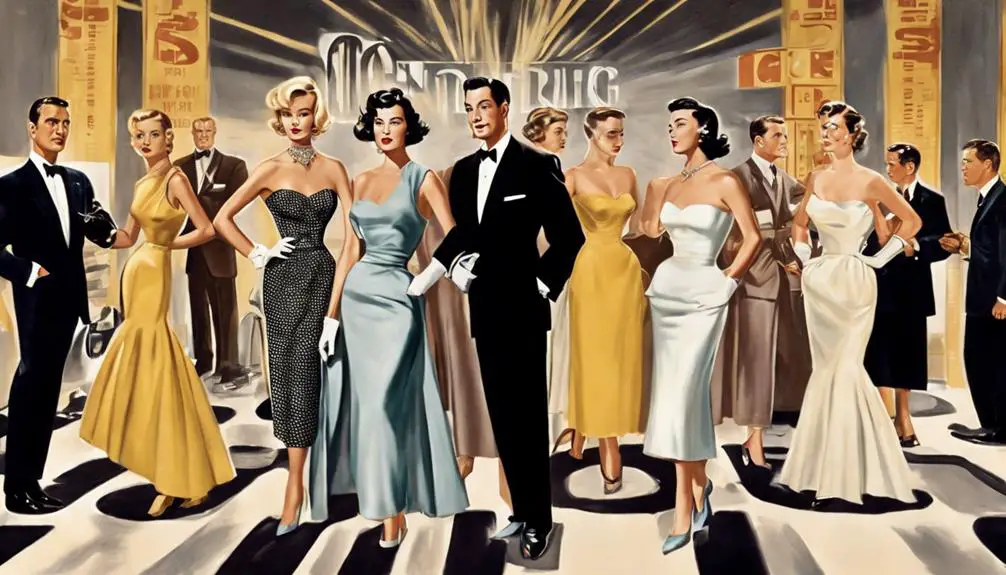
Hollywood's glamorous stars transformed fashion in the 1950s, turning the silver screen into a powerful runway. Icons like Marilyn Monroe and Audrey Hepburn set new standards with their unique styles, influencing clothing trends for women everywhere. Monroe's iconic dresses dazzled audiences, while Hepburn's sophisticated looks, often paired with elegant evening wear, showcased a refined silhouette that many aspired to emulate.
The evolution of designer labels during this time, similar to how vintage fashion identification has become an art form today, created a greater connection between celebrity culture and fashion trends.
The use of color film in cinema during this era heightened the visual appeal of fashion, allowing designers to present their creations in vibrant hues that captivated the public. Designers like Christian Dior and Chanel capitalized on this trend, crafting stunning collections that drew inspiration from Hollywood's elite. Dior's "New Look" revolutionized women's fashion, emphasizing a cinched waist and full skirts that became synonymous with femininity.
Hollywood didn't just influence high-end fashion; it also popularized casual styles among the youth. Films like "Rebel Without a Cause" introduced denim jackets and fitted t-shirts, making them staples in everyday wardrobes.
The allure of the silver screen permeated all levels of fashion, making it accessible and desirable to the masses. Events like Grace Kelly's wedding in 1956, where she wore an exquisite gown designed by Helen Rose, further emphasized Hollywood's impact.
Such moments created aspirational symbols of style and elegance, proving that the connection between Hollywood and fashion wasn't just superficial—it shaped how people dressed in their everyday lives.
Iconic Styles From the 1950S
In the 1950s, fashion took a bold turn with styles that defined an era. Designers like Christian Dior set the stage with his revolutionary "New Look," which featured nipped-in waists and full skirts that highlighted a woman's curves. This style became synonymous with femininity and elegance, influencing countless wardrobes.
Chanel, known for her timeless designs, also made her mark with the iconic Chanel suit, a piece that's still revered today for its vintage significance. This creation featured boxy jackets that offered practical elegance, reshaping women's fashion for the modern age. It was a perfect blend of comfort and style, allowing women to feel empowered while looking chic.
Balenciaga introduced the sack dress, a radical departure from fitted styles. Its loose silhouette challenged traditional notions of femininity, making it a staple for those who sought freedom in their fashion choices.
Meanwhile, Hubert de Givenchy captured hearts with the little black dress, which became a quintessential piece for sophisticated elegance, perfect for any occasion.
Lastly, Pierre Balmain's luxurious designs showcased intricate embroidery and rich fabrics, embodying the post-war glamour that defined the decade.
To summarize the iconic styles of the 1950s, consider these key pieces:
- Dior's New Look
- Chanel's iconic Chanel suit
- Givenchy's little black dress
- Balenciaga's sack dress
These designs not only transformed fashion but also inspired generations to come, proving that style can be both innovative and timeless.
Cultural Influences on Fashion Trends
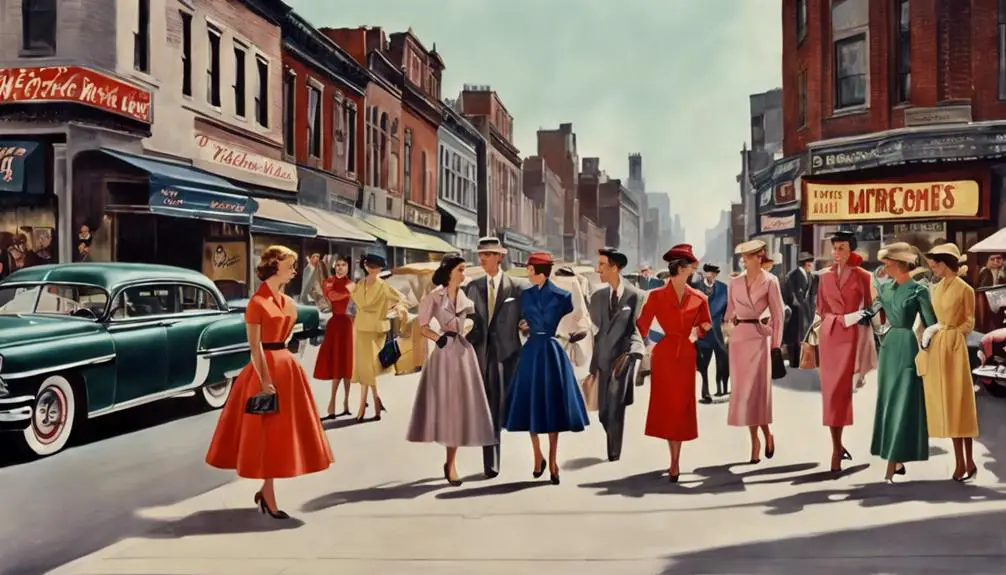
Cultural influences in the 1950s reshaped fashion, reflecting the era's dynamic social landscape. After World War II, prosperity blossomed, and a consumer culture emerged where fashion became a symbol of wealth and status. Designers like Christian Dior played an essential role, introducing elegant silhouettes that redefined women's wardrobes. His attention to detail and exclusive offers captivated shoppers, making haute couture accessible to many.
This period also saw the rise of influential designers like Yves Saint Laurent, whose innovative styles would later revolutionize women's fashion. Hollywood glamour also loomed large during this time. Stars like Audrey Hepburn and Marilyn Monroe set trends that the public enthusiastically emulated. Their styles often blended sophistication with a touch of allure, inspiring countless women to mimic their looks.
The influence of cinema and music, particularly the rise of rock and roll, introduced casual wear into mainstream fashion. Icons like Elvis Presley popularized denim and leather, appealing to the burgeoning youth culture that craved a sense of rebellion.
As the decade progressed, subcultures like greasers and beatniks emerged, presenting contrasting styles that pushed against the more structured fashions of the day. This clash of aesthetics enriched the fashion world, leading to a diverse array of trends.
From the elegance of Dior's New Look to the laid-back vibes of youth culture, the 1950s showcased a vibrant tapestry of cultural influences that left an indelible mark on fashion. You can see how these elements combined to create a unique and exciting era in style that still resonates today.
